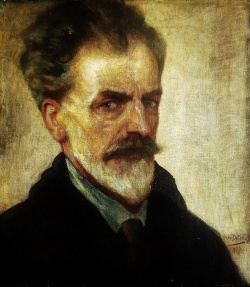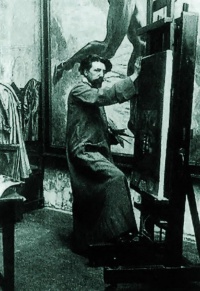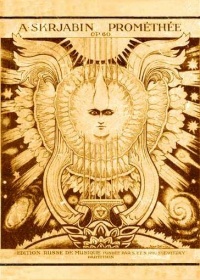Jean Delville: Difference between revisions
No edit summary |
No edit summary |
||
| Line 1: | Line 1: | ||
[[File:Jean Delville self-portrait.jpg|right|250px|thumb|Jean Delville, self-portrait]] | |||
'''Jean Delville''' (1867–1953) was a Belgian symbolist painter, author, and teacher. He was the first General Secretary of the Theosophical Society in Belgium, in 1911. | |||
== Early years == | |||
[[File:Jean Delville self-portrait at age 20.jpg|left|130px|thumb|Self-portrait at age 20]] | |||
Jean Delville was born in Louvain, Belgium on [[July 10]], 1867. At the age of 17 he was the prize-winner at the School of Arts in Brussels.<ref>"Who's Who in the Theosophical Society: Delville, Jean," ''The Theosophical Year Book, 1938'' (Adyar, Madras, India: Theosophical Publishing House, 177.</ref> | |||
<br> | |||
<br> | |||
<br> | |||
== Artistic career == | |||
<br> | |||
<br> | |||
[[File:Jean Delville in his studio.jpg|right|200px|thumb|Delville in his studio]] | |||
<br> | |||
=== Artistic style === | |||
<br> | <br> | ||
<br> | <br> | ||
<br> | <br> | ||
''' | === Paintings, exhibitions, and prizes === | ||
* First exhibition, in 1885, featured ''Cycle Passionel'' | |||
* ''Christ Glorified by the Children'' won Grand Prix de Rome in 1895 | |||
* "Treasures of Patin'' in 1895 | |||
* ''The School of Plato'' in 1899 | |||
* ''Love of Souls'' | |||
* ''Prometheus'' cover art for Scriabin's score | |||
* Murals in Palais de Justice, Brussels in 1914 | |||
* ''The Shudder of the Sphinx'' | |||
* ''The Unknown Splendours'' | |||
* ''The Haunted Horizon'' | |||
=== Organizations of artists === | |||
In 1896, Delville founded the Salon d'art Idéalist. | |||
<br> | |||
== Theosophical Society involvement == | |||
Delville became a member of the [[Theosophical Society]] on ................ | |||
Delville was a founder of the '''Theosophical Society in Belgium''' and served as its first General Secretary in the years 1911-1913, with Gaston Polak succeeding him.<ref>"General Secretaries Past and Present," ''The Theosophical Year Book, 1938'' (Adyar, Madras, India: Theosophical Publishing House, 152.</ref> | |||
<br> | |||
<br> | |||
<br> | |||
<br> | |||
<br> | |||
<br> | |||
[[File:Prometheus Symphony art.jpg|200px|right|thumb|Cover of score for Scriabin's ''Prometheus'']] | |||
== Friendship with Sciabin == | |||
In 1908, Russian composer and pianist [[Alexander Scriabin]] relocated to Brussels, and there met Delville. | |||
When Scriabin composed his fifth symphony, ''Prometheus'' or "The Poem of Fire" in 1909-1910, Delville created the cover art for the score. | |||
<blockquote> | |||
Delville, and perhaps Scriabin, had joined a secret cult within Theosophy called "Sons of the Flames of Wisdom." They worshiped Prometheus, because those fires, colors, lights were metasymbols of man's highest thoughts. Fire was Prometheus's stolen gift to man...<ref>Faubion Bowers, ''Scriabin: A Biography of the Russian Composer 1871-1915, Volume II'' (Tokyo:Kodansha International Ltd, 1969), 206-207.</ref> | |||
</blockquote> | |||
Scriabin was delighted with the androgynous face and the symbolism. | |||
== Old notes == | |||
According to [https://en.wikipedia.org/wiki/Jean_Delville Wikipedia]: | According to [https://en.wikipedia.org/wiki/Jean_Delville Wikipedia]: | ||
| Line 23: | Line 78: | ||
[[Category:Poets|Delville, Jean]] | [[Category:Poets|Delville, Jean]] | ||
[[Category:Nationality Belgian|Delville, Jean]] | [[Category:Nationality Belgian|Delville, Jean]] | ||
[[Category:Famous people|Delville, | [[Category:Famous people|Delville, Jean]] | ||
Revision as of 01:28, 15 October 2016
Jean Delville (1867–1953) was a Belgian symbolist painter, author, and teacher. He was the first General Secretary of the Theosophical Society in Belgium, in 1911.
Early years
Jean Delville was born in Louvain, Belgium on July 10, 1867. At the age of 17 he was the prize-winner at the School of Arts in Brussels.[1]
Artistic career
Artistic style
Paintings, exhibitions, and prizes
- First exhibition, in 1885, featured Cycle Passionel
- Christ Glorified by the Children won Grand Prix de Rome in 1895
- "Treasures of Patin in 1895
- The School of Plato in 1899
- Love of Souls
- Prometheus cover art for Scriabin's score
- Murals in Palais de Justice, Brussels in 1914
- The Shudder of the Sphinx
- The Unknown Splendours
- The Haunted Horizon
Organizations of artists
In 1896, Delville founded the Salon d'art Idéalist.
Theosophical Society involvement
Delville became a member of the Theosophical Society on ................
Delville was a founder of the Theosophical Society in Belgium and served as its first General Secretary in the years 1911-1913, with Gaston Polak succeeding him.[2]
Friendship with Sciabin
In 1908, Russian composer and pianist Alexander Scriabin relocated to Brussels, and there met Delville.
When Scriabin composed his fifth symphony, Prometheus or "The Poem of Fire" in 1909-1910, Delville created the cover art for the score.
Delville, and perhaps Scriabin, had joined a secret cult within Theosophy called "Sons of the Flames of Wisdom." They worshiped Prometheus, because those fires, colors, lights were metasymbols of man's highest thoughts. Fire was Prometheus's stolen gift to man...[3]
Scriabin was delighted with the androgynous face and the symbolism.
Old notes
According to Wikipedia:
In 1895 Delville published his Dialogue entre nous, a text in which he outlined his views on occultism and esoteric philosophy. Brendan Cole discusses this text in detail his book on Delville, pointing out that, though the Dialogue reflects the ideas of a number of occultists, it also reveals a new interest in Theosophy. In the late 1890s, Delville joined the Theosophical Society. He was probably introduced to Theosophy directly through his friendship with Edouard Schuré, the author of the widely-influential book Les Grandes Initiés. Schuré wrote the preface to Delville's work on Idealist Art, La Mission de l'Art (1900). Delville also came into close alliance with Annie Besant who inherited the leadership of the Theosophical movement. Besant gave a series of lectures in Brussels in 1899 titled La Sagesse Antique. Delville reviewed her talks in an article published in Le Thyrse that year.[4] It is probably from this point onwards that Delville became actively involved in the Theosophical Movements as such. Delville founded La Lumière, a journal devoted to Theosophical ideas in 1899, and published articles from leading Theosophists of the day, including Besant. Delville became the first General Secretary of the Belgian branch of the Theosophical Society in 1911.[5]
Delville's art flourished after 1900 and he produced some of his greatest works during this period up to the First World War. He worked with undiminished strength and imagination and his paintings revealed a visionary sense of the transcendental inspired by his involvement in the Theosophical movement, seen typically in works such as his monumental L'Homme-Dieu (1903, Brughes: Groeninge Museum) and Prométhée (1907, Free University Brussels).
Notes
- ↑ "Who's Who in the Theosophical Society: Delville, Jean," The Theosophical Year Book, 1938 (Adyar, Madras, India: Theosophical Publishing House, 177.
- ↑ "General Secretaries Past and Present," The Theosophical Year Book, 1938 (Adyar, Madras, India: Theosophical Publishing House, 152.
- ↑ Faubion Bowers, Scriabin: A Biography of the Russian Composer 1871-1915, Volume II (Tokyo:Kodansha International Ltd, 1969), 206-207.
- ↑ Delville, 'A propos de la Sagesse Antique. Conference de Mme Annie Besant', Le Thyrse, nr 9, 1st September 1899, pp. 65-6.
- ↑ See Flaurette Gautier, Jean Delville et l'occulture fin de siècle. Unpublished Master's thesis, Tours: University François-Rabelais, 2012.
Online resources
Articles
- Jean Delville: Painting, Spirituality, and the Esoteric by Lynda Harris
- Jean Delville at Wikipedia



